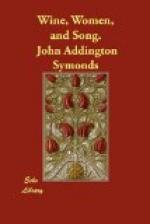[Footnote 3: Du Meril, Poesies Populaires Latines du Moyen Age, p. 196.]
[Footnote 4: Du Meril, Poesies Pop. Lat. Ant., pp. 278, 241, 275.]
[Footnote 5: These extraordinary compositions will be found on pp. 174-182 of a closely-printed book entitled Carmina Med. Aev. Max. Part. Inedita. Ed. H. Hagenus. Bernae. Ap. G. Frobenium. MDCCCLXXVII. The editor, so far as I can discover, gives but scant indication of the poet who lurks, with so much style and so terrible emotions, under the veil of Cod. Bern., 702 s. Any student who desires to cut into the core of cloister life should read cvii. pp. 178-182, of this little book.]
VI.
There is little need to dwell upon these crepuscular stirrings of popular Latin poetry in the earlier Middle Ages. To indicate their existence was necessary; for they serve to link by a dim and fragile thread of evolution the decadent art of the base Empire with the renascence of paganism attempted in the twelfth century, and thus to connect that dawn of modern feeling with the orient splendours of the fourteenth and fifteenth centuries in Italy.
The first point to notice is the dominance of music in this verse, and the subjugation of the classic metres to its influence. A deeply significant transition has been effected from the versus to the modulus by the substitution of accent for quantity, and by the value given to purely melodic cadences. A long syllable and a short syllable have almost equal weight in this prosody, for the musical tone can be prolonged or shortened upon either. So now the cantilena, rather than the metron, rules the flow of verse; but, at the same time, antique forms are still conventionally used, though violated in the using. In other words, the modern metres of the modern European races—the Italian Hendecasyllable, the French Alexandrine, the English Iambic and Trochaic rhythms—have been indicated; and a moment has been prepared when these measures shall tune themselves by means of emphasis and accent to song, before they take their place as literary schemes appealing to the ear in rhetoric. This phase, whereby the metres of antiquity pass into the rhythms of the modern races, implies the use of medieval Latin, still not unmindful of classic art, but governed now by music often of Teutonic origin, and further modified by affinities of prosody imported from Teutonic sources.
The next point to note is that, in this process of transition, popular ecclesiastical poetry takes precedence of secular. The great rhyming structures of the Middle Ages, which exercised so wide an influence over early European literature, were invented for the service of the Church—voluminous systems of recurrent double rhymes, intricate rhythms moulded upon tunes for chanting, solid melodic fabrics, which, having once been formed, were used for lighter efforts of the fancy, or lent their ponderous effects to parody. Thus, in the first half of the centuries which intervene between the extinction of the genuine Roman Empire and the year 1300, ecclesiastical poetry took the lead in creating and popularising new established types of verse, and in rendering the spoken Latin pliable for various purposes of art.




